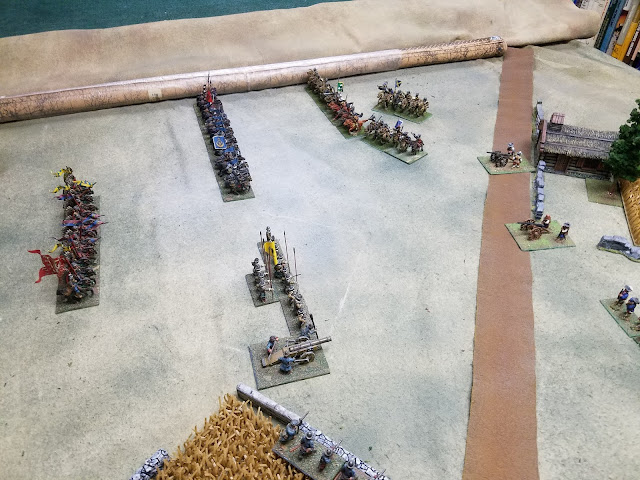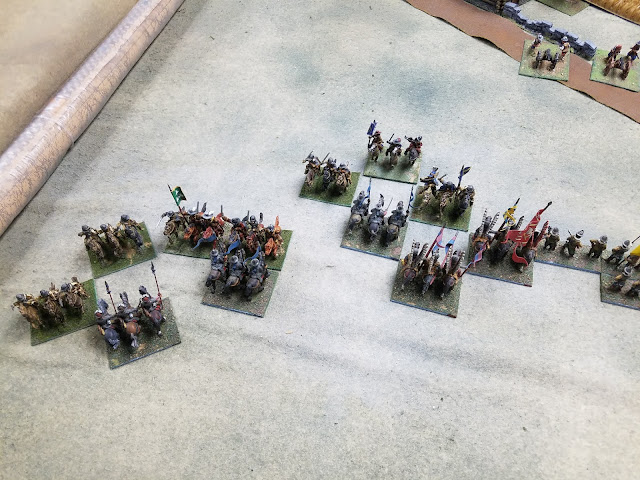My friend Bob & I have a large collection of 28mm figures for the Marian Roman period 105-25 BC. In addition to large Roman forces, we also have several historical opponent armies for the DBA 3.0 rules, including Gauls, Early Germans, Parthians, Spanish, Numidians, & Ancient Britons. We have the figures to do a Spartacus Slave Revolt army (74-70 BC), but just have never gotten round to having them painted. Well, we were able to assemble a Spartacus Slave Revolt army recently when Bob scrounged together a few Gladiator figures, plus some odds & ends Gaul, German, & generic barbarian types that were already painted. Some "flying carpets" or "sabot" bases were made for the 5Horde (5Hd) elements in the army, which each held a psiloi skirmisher stand and a 3 Warband (3Wb) stand, which together made a 5Hd stand.
The armies for our first battle are as follows:
Roman Army of Crassus:
1 x Roman Cavalry with CinC (Crassus) attached
1 x Roman Cavalry (Cv)
5 x Legionaries (4Bd)
1 x Roman Light Horse (LH)
2 x Greek Mercenaries (4Ax)
1 x Thracian Mercenaries (3Ax)
1 x Skirmishers (Ps)
Slave Revolt Army of Spartacus:
1 x Ex-Slave Cavalry with CinC (Spartacus) attached
3 x Ex-Slaves with miscellaneous armor & weapons (4Bd)
1 x Ex-Gladiators/veterans with miscellaneous armor & weapons (4Bd)
1 x Ex-Slave Gauls fighting in native style (3Wb)
2 x Ex-Slave herdsmen skirmishers (Ps)
4 x various Ex-Slaves, peasants, the oppressed, etc. (5Hd)
For our battle, we used terrain similar to that in the Stanley Kubrick film "Spartacus," mostly clear with two large ridges on opposite sides.
Above, the Ex-Slave Revolt army is deployed along the top of a long ridge. The crestline is forward outlined in chalk. Books under the game mat made the ridge. The ruins in the background are the Slave camp.
The Roman army of Crassus deployed on the opposite ridge. The Roman camp is in the background.
The Ex-Slave army has moved forward to the edge of the ridge-top. Ex-Slaves with various armor & weapons, classified as "4Blades" or 4Bd are in the foreground.
Ex-Gladiators with various armor & weapons, also classified as 4Bd. Note the sabot base of hordes next to them.
The entire horde infantry group. Being on top of the ridge is a good position for the horde as it gives them a +1 advantage in close combat, plus the horde do not recoil when beaten by ordinary infantry, they just stand and must be destroyed (doubled in combat) to be hurt.
The armies approach each other.
Another view.
While the Romans were sizing up their opponent, the Ex-Slaves shifted their left flank forward; the Ex-Gladiators & Gauls at the top of the ridge while a force of skirmishing herdsmen moved forward.
Crassus' element shifts to the right to provide better command control for the Roman right flank, ensuring all the elements are within 8 base widths. The Roman skirmishers move forward from the rear.
The herdsmen/skirmishers move forwards towards the Roman light horse on the Roman right flank.
The Romans counter by moving up 2 elements of Greek & Thracian peltasts to support the light horse, under the direct supervision of Crassus, who has moved closer.
Crassus now moves an element of legionaries up to support his right flank.
After Crassus moves to cover the gap between his right and center, the Slaves decide to charge the Roman light horse and peltasts.
A close-up of the action.
The result of the combat is the Romans lose the Greek Mercenaries to the Gauls, while the Roman light horse destroys a herdsmen/skirmisher stand.
The Romans counter attack by turning the flank of the herdsmen while the Thracians held their front. The Legionaries moved into contact with the Gauls while Crassus' cavalry element provides corner support. The Ex-Gladiators look on from the top of the ridge.
Both Ex-Slave army elements are destroyed.
The Ex-Gladiators move next to the horde for support. The Romans organize a pursuit. At this point, the Romans lead the Ex-Slaves 3-1.
A couple turns later, the Ex-Gladiators sense an opportunity & attack the Legionaries.
Crassus senses victory is within his grasp, and the Ex-Gladiators are enveloped.
The Ex-Gladiators are cut down, and the battle is over with a Roman win, 4-1. Crassus raises his gladius in a sign of victory.
Post Mortem:
The Ex-Slave army initially had the right tactics, deploying on the high ground. The Romans picked the weakest wing to attack (the Ex-Slave left flank) that had 2 skirmisher elements, 1 warband and 1 blade element. The Ex-Slave attack coming off the ridge by their left was probably unwise (though the Romans had shown no sign of attacking yet and someone had to start), and the Romans effectively strengthened their right to deal with it. The Ex-Slaves may have been able to cause the Romans consternation if their right had moved forward to threaten the Roman left, now weakened by Crassus' absence.
The Ex-Slave army may be a bit challenged, as it's troop mix is not the best. Bob & I were thinking it might be fun to have an optional, Hollywood inspired "flaming log" rule to simulate the last battle scene in the movie "Spartacus." Something like allowing all Ex-Slave elements to launch a one-time only "flaming log" distant combat on enemy troops that are both within 1 base width and at a lower elevation, etc., with the Ex-Slaves being allowed to follow-up any Romans recoils with a charge into contact at +1. Maybe next time.


















































